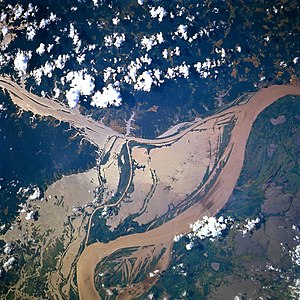Uatuma-Trombetas moist forests
| Uatuma-Trombetas moist forests | |
|---|---|

Section of the Amazon River midway between Manaus and the coast. The Trombetas River flows from the northwest (upper right) into the Amazon.
|
|
| Ecology | |
| Realm | Neotropical |
| Biome | Tropical and subtropical moist broadleaf forests |
| Geography | |
| Area | 473,190 km2 (182,700 sq mi) |
| Country | Brazil |
| Coordinates | 0°05′13″S 55°48′18″W / 0.087°S 55.805°WCoordinates: 0°05′13″S 55°48′18″W / 0.087°S 55.805°W |
The Uatuma-Trombetas moist forests (NT0173) is an ecoregion in northwest Brazil in the Amazon biome. It covers the Amazon basin north of the Amazon River from close to the Atlantic ocean to the Rio Negro west of Manaus. The ecoregion is relatively intact, although it has been damaged along the main rivers and around population centers.
The Uatuma-Trombetas moist forests ecoregion is in the north of Brazil in parts of the states of Roraima, Amazonas and Amapá to the north of the Amazon River. Small areas of the ecoregion cross the Brazilian border into Guyana and Suriname. It has an area of 47,319,082 hectares (116,928,000 acres). The ecoregion covers the area to the north of the Amazon River from close to the Atlantic coast to the Rio Negro and the Branco River. In the north to extends to the mountains along the border between Brazil and the Guianas and Suriname. On the 1993 Brazilian Institute of Geography and Statistics map the Brazilian part is shown as "lowland ombrophilous dense forests", "submontane ombrophilous dense forests" and "ombrophilous forest – savanna transition".
The Uatuma-Trombetas moist forests ecoregion is bounded to the south by the Monte Alegre várzea, Gurupa várzea and Marajó várzea ecoregions along the Amazon River. It adjoins sections of the Guianan savanna ecoregion to the east and north, but most of the northern border adjoins the Guianan moist forests ecoregion. In the northwest it adjoins a section of the Guayanan Highlands moist forests ecoregion. The western part of the Uatuma-Trombetas ecoregion contains large areas of Rio Negro campinarana. To the west it adjoins Guianan piedmont and lowland moist forests, Negro-Branco moist forests and Japurá-Solimões-Negro moist forests.
...
Wikipedia
